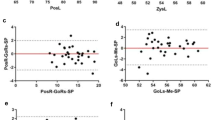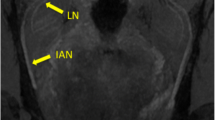Abstract
Purpose
No study has investigated intermammillary relationships using neuroimaging modalities. This study aimed to explore them using magnetic resonance imaging (MRI).
Materials and methods
We enrolled 72 patients who underwent conventional MRI examinations, followed by constructive interference steady-state sequence in the coronal plane. The intermammillary distances (IMDs) were measured at the uppermost level of the intermammillary gap (IMDupp) and the lowest level (IMDlow) of the mammillary bodies (MBs).
Results
MBs with varying morphologies were consistently delineated. The appearance of both MBs could be classified into four patterns based on the size and relative levels, with the symmetrical type being the most common. Intermammillary relationships exhibited five patterns. In 69%, the IMDupp was discernible and measured 0.7 ± 0.4 mm, while it was not discernible in 31% due to the presence of intermammillary connection and adhesion. The age distribution did not differ between populations with and without discernible IMDupp. The IMDlow was measured 4.4 ± 0.9 mm. Although the IMDlow was not significantly different between both sexes; it was longer in subjects in their 70s.
Conclusions
Intermammillary relationships show variable morphologies with gaps formed between both MBs. The IMDlow may become more evident in association with age-related increase in the width of the third ventricle and atrophy of the MBs.





Similar content being viewed by others
Availability of data and materials
The data and materials used in this study are available from the corresponding author on reasonable request (Satoshi Tsutsumi).
References
Di Vincenzo J, Keiner D, Gaab MR, Schroeder HW, Oertel JM (2014) Endoscopic third ventriculostomy: preoperative considerations and intraoperative strategy based on 300 procedures. J Neurol Surg A Eur Neurosurg 75:20–30. https://doi.org/10.1055/s-0032-1328953
Ghaderi Niri S, Khalaf AM, Massoud TF (2020) The mammillothalamic tracts: age-related conspicuity and normative morphometry on brain magnetic resonance imaging. Clin Anat 33:911–919. https://doi.org/10.1022/ca.23595
Iaccarino C, Tedeschi E, Rapanà A, Massarelli I, Belfiore G, Quarantelli M, Bellotti A (2009) Is the distance between mammillary bodies predictive of a thickened third ventricle floor? J Neurosurg 110:852–857. https://doi.org/10.3171/2008.4.17539
Kinoshita F, Kinoshita T, Toyoshima H, Shinohara Y (2019) Ipsilateral atrophy of the mammillary body and fornix after thalamic stroke: evaluation by MRI. Acta Radiol 60:1512–1522. https://doi.org/10.1177/0284185119839166
Meys KME, de Vries LS, Groenendaal F, Vann SD, Lequin MH (2022) The mammillary bodies: a review of cases of injury in infants and children. AJNR Am J Neuroradiol 43:802–812. https://doi.org/10.3174/ajnr.A7463
Ozturk A, Yousem DM, Mahmood A, El Sayed S (2008) Prevalence of asymmetry of mammillary body and fornix size on MR imaging. AJNR Am J Neuroradiol 29:384–387. https://doi.org/10.3174/ajnr.A0801
Parvizi J, Le S, Foster BL, Bourgeois B, Riviello JJ, Prenger E, Saper C, Kerrigan JF (2011) Gelastic epilepsy and hypothalamic hamartomas: neuroanatomical analysis of brain lesions in 100 patients. Brain 134:2960–2968. https://doi.org/10.1093/brain/awr235
Preul C, Hund-Georgiadis M, Forstmann BU, Lohmann G (2006) Characterization of cortical thickness and ventricular width in normal aging: a morphometric study at 3 Testa. J Magn Reson Imaging 24:513–519. https://doi.org/10.1002/jmri.20665
Quester R, Schröder R (1997) The shrinkage of the human brain stem during formalin fixation and embedding in paraffin. J Neurosci Methods 75:81–89. https://doi.org/10.1016/s0165-0270(97)00050-2
Raz N, Torres IJ, Acker JD (1992) Age-related shrinkage of the mammillary bodies: in vivo MRI evidence. NeuroReport 3:713–716. https://doi.org/10.1097/00001756-199208000-00016
Romero Adel C, Aguiar PH, Borchartt TB, Conci A (2011) Quantitative ventricular neuroendoscopy performed on the third ventriculostomy: anatomic study. Neurosurgery 68:347–354. https://doi.org/10.1227/NEU.0b013e318211449a
Schulz G, Crooijmans HJ, Germann M, Scheffler K, Müller-Gerbl M, Müller B (2011) Three-dimensional strain fields in human brain resulting from formalin fixation. J Neurosci Methods 202:17–27. https://doi.org/10.1016/j.jneumeth.2011.08.031
Shah A, Jhawar SS, Goel A (2012) Analysis of the anatomy of the Papez circuit and adjoining limbic system by fiber dissection techniques. J Clin Neurosci 19:289–298. https://doi.org/10.1016/j.jocn.2011.04.039
Tagliamonte M, Sestieri C, Romani GL, Gallucci M, Caulo M (2015) MRI anatomical variants of mammillary bodies. Brain Struct Funct 220:85–90. https://doi.org/10.1007/s00429-013-00639-y
Tubbs RS, Hattab EM, Loukas M, Chern JJ, Wellons M, Wellons JC 3rd, Iskandar BJ, Cohen-Gadol AA (2012) Histological analysis of the third ventricle floor in hydrocephalic and nonhydrocephalic brains: application to neuroendocrine complications following third ventriculostomy procedures. J Neurosurg Pediatr 9:178–181. https://doi.org/10.3171/2011.11.PEDS11290
Yamada K, Shrier DA, Rubio A, Yoshiura T, Iwanaga S, Shibata DK, Patel U, Numaguchi Y (1998) MR imaging of the mammillothalamic tract. Radiology 207:593–598. https://doi.org/10.1148/radiology.207.3.9609878
Funding
No funding was received for this study.
Author information
Authors and Affiliations
Contributions
ST conceived the study, performed the cadaver dissection, and wrote the manuscript. NS and HU collected the imaging data. ST and HI analyzed the imaging data.
Corresponding author
Ethics declarations
Conflict of interest
The authors declare that they have no conflicts of interest of a financial or personal nature.
Ethical approval
All procedures in this study were performed in accordance with the ethical standards of the institutional and/or national research committee, and the 1964 Declaration of Helsinki and its later amendments or comparable ethical standards.
Informed consent
Written informed consent was obtained from all participants included in the study for participation and publication of the article.
Additional information
Publisher's Note
Springer Nature remains neutral with regard to jurisdictional claims in published maps and institutional affiliations.
Rights and permissions
Springer Nature or its licensor (e.g. a society or other partner) holds exclusive rights to this article under a publishing agreement with the author(s) or other rightsholder(s); author self-archiving of the accepted manuscript version of this article is solely governed by the terms of such publishing agreement and applicable law.
About this article
Cite this article
Tsutsumi, S., Sugiyama, N., Ueno, H. et al. Delineation of intermammillary relationships using magnetic resonance imaging. Surg Radiol Anat 45, 29–34 (2023). https://doi.org/10.1007/s00276-022-03063-x
Received:
Accepted:
Published:
Issue Date:
DOI: https://doi.org/10.1007/s00276-022-03063-x




